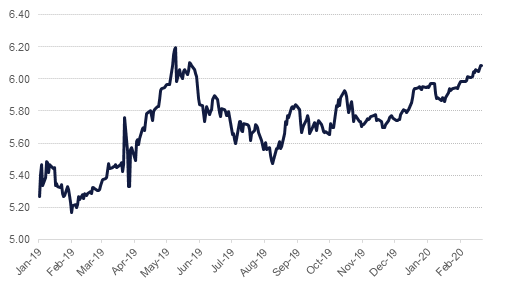
The Turkish central bank cut its benchmark one-week repo by 50bps to 10.75% yesterday, in line with consensus expectations. The TCMB made the cut despite the fact that the uptick in inflation in January to 12.15% y/y means that real rates have been pushed deeper into negative territory by the adjustment, at -1.40%. Nor was an ongoing lira sell-off, with the currency depreciating to levels last seen in May 2019, sufficient to deter Governor Murat Uysal from implementing the sixth consecutive rate cut in the current cycle. Uysal has maintained that disinflation will resume after the first quarter, returning real rates to positive territory, but the risk is that cutting too swiftly, raising concerns around political pressure, will prompt a renewed lira sell-off. While a cut in rates was expected, the scale was perhaps wider than the market anticipated hence the lira jumped sharply against the USD, closing over 6.08, a 0.3% depreciation.
Inflation in the UK accelerated to 1.8% y/y in January, faster than market expectations and a jump from 1.3% a month earlier. Core inflation also moved higher to 1.6% from 1.5% previously. The price boost was largely down to fuel prices as there was a low base effect from January 2019. Producer price inflation, though, remains relatively subdued at just over 1%. Sterling initially moved back above well 1.30 against the dollar on the inflation report before giving up ground later in the day.
The minutes from the Federal Reserve’s last meeting showed that the central bank was relatively optimistic over the outlook for growth in 2020 as they saw diminishing trade risks. However, the meeting was carried out prior to the full scale outbreak of the coronavirus and the macro picture at the start of the year was admittedly stronger than it is today. More critically for markets, Fed policymakers discussed at length the underperformance of inflation in the US and remain committed to allowing inflation to run hotter than its 2% target, if it indeed does return to that level.
 Source: Bloomberg, Emirates NBD Research
Source: Bloomberg, Emirates NBD Research
Treasuries remained in a tight range as investors continued to play the probable impact of coronavirus on global economy through fixed income securities. The Federal Reserve meeting minutes threw no surprise as policymakers saw the current rate as appropriate but did refer to the outbreak as a potential risk. Yields on the 2y UST and 10y UST closed 1.42% (+1 bp) and 1.56% (flat) respectively.
Regional bonds continued their positive run. However gains were very marginal compared to moves in benchmark yields. The YTW on Bloomberg Barclays GCC Credit and High Yield index remained at 2.93% and credit spreads tightened 2 bps to 140 bps.
The dollar gained on other major currencies following supportive economic data from the US. A 9.2% rise in building permits, the highest level in almost 13 years, and the tone of the FOMC minutes from the last meeting helped the dollar reach and remain near three-year highs. The minutes implied that policy makers expected the current level of interest rates to “remain appropriate for a time”. As we go to print, EURUSD is trading at the 1.0800 level while USDJPY is trading at 111.35.
AUD has seen the biggest decline against the dollar, falling to 0.6634. This move was triggered by the release of employment data which showed that the unemployment rate rose to 5.3% in January, up from 5.1% the previous month. This is the latest in a raft of negative fundamentals for the AUD. Following the RBA minutes released earlier in the week that communicated the RBA is willing to ease further if needed and the interest rate cut from the PBOC, the AUD may remain under pressure in the medium term.
Developed market equities rallied on the back of continued strength in some outperforming sectors and stocks. The S&P 500 index and the Euro Stoxx 600 index added +0.5% and +0.8% respectively.
Regional markets had a positive day following continued strength in oil prices and upbeat cues from global markets. The Tadawul and the Qatar Exchange added +1.4% and +1.1% respectively. The rally was led by market heavyweights with Saudi Aramco adding +0.6% and Industries Qatar gaining +1.8%.
Oil prices extended their gains overnight despite estimates that China’s refinery run rates have been slashed by as much as 25%. Both Brent and WTI jumped nearly 2.4% to settle at USD 59.12/b and USD 53.29/b respectively. Anticipation of more stimulus from China’s government—largely in the form of indirect monetary assistance—is also helping oil prices move higher.
OPEC has confirmed its next meeting for the start of March—quashing any hopes for any immediate action by the producers’ bloc. OPEC will need to decide whether to extend its latest deeper cuts beyond their slated expiry at the end of Q1